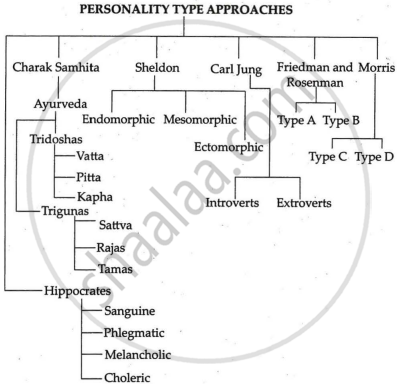Advertisements
Advertisements
Question
A number of theories have been used to understand 'personality'. Discuss how efforts have been inade to categorise people into personality types since ancient times.
Solution
Type theory presumes that people can be categorised into a series of categories or types based on no overlapping characteristics.

- Greek physician Hippocrates, regarded as the “father of modern medicine,” held that a person’s physical and mental health were interconnected. To extend his idea, he suggested four personality types based on the temperament’s major humour and fluids.
- Sanguine: cheerful, active and optimistic.
- Phlegmatic: touchy, sluggish, calm and apathetic.
- Melancholic: sad, broocling and morose.
- Choleric: irritable, hot-tempered and excitable.
- The three “Dashas”—Vata, Pitta, and Kapha—that make up the Indian discipline of medicine, known as Ayurveda, or Charak Samhita, are used to categorise persons.
- Based on qualities (gunas), there are three different types of personalities.
- Sattva: The qualities of sincerity, detachment, discipline, keen intelligence, self-control, and spirituality are included in the Sattva Guna.
- Rajas: Rajas Guna consists of some worldly characteristics, such as the need for instant gratification and a materialistic mindset. They are both inventive and envious.
- Tamas: The Tamas Guna is made up of all the vices in the world, including mental instability, rage, arrogance, laziness, etc.
Based on the physical constitution, Sheldon has categorised personalities.- Endomorphic: They are big, soft, and round, and they are relaxed and social, like eating and enjoying themselves.
- Mesomorphic: They have a rectangular, well-built body shape with a strong muscular structure. They are bold, energetic, assertive, and dominating.
- Ectomorphic: They have a body shape that is long, thin, and fragile. They are brainy, artistic, introvert and are fond of solitude and inward-looking.
- Carl Jung grouped all people into:
- Introverts: They are socially withdrawn, passive, quiet, cautious and reserved.
- Extroverts: Socially outgoing, talkative, impulsive and thrill-seeking.
- Meyer Friedman and Ray Rosenman (1974) identified psychological variables and suggested that individuals can be grouped into two personality types:
- Type-A: Type-A, coronary-prone behaviour pattern. They are never content, constantly pressed for time, overworked, and competitive.
- Type-B: The neutral behaviour pattern, often known as type B, is marked by an easygoing, relaxed way of life.
-
More recent research by Morris has suggested Type-C and Type-D personalities.
-
Type-C personalities are cancer-prone and are defined by their lack of aggressiveness, suppression of anger, and submission to external authorities to avoid disputes.
-
Type-D personalities are generally pessimistic and prone to depression.
-
APPEARS IN
RELATED QUESTIONS
How does Freud explain the structure of personality?
Which of the following lists presents Freud’s psychosexual stages in the order in which they occur?
Anjani just found a gold bracelet inside a movie theatre. Which part of her personality would urge her to deposit it at the manager’s office?
Collective unconscious consists of _____ that are not individually acquired but are inherited.
Two statements are given in the question below as Assertion (A) and Reasoning (R).
Assertion (A): A person who has strong aggressive tendencies may see other people as being excessively aggressive towards him/her.
Reason (R): People adopt an ego defense mechanism called projection in which they attribute their own traits to others.
Discrepancy between the real self and ideal self often results in ______.
Sixteen Personality Factor (16 PF) Questionnaire was developed by ____________.
Analysis of avoidance learning suggest that many phobias are acquired through ______ conditioning.
Which is the correct sequence of the stages involved in creative thinking?
In Erikson's theory, which psycho-social crises proceed and succeed Autonomy v/s Shame:
When is aspiration a method of choice to make a lesion?
______ is goal-oriented behavior that leads to driving a reduction in the organism.
The process by which the stimulus decreases the probability of preceding behavior.
______ may be described as changes that take place in particular parts of the body and in the behavior of an organism.
Who first attempted to describe personality traits in terms of Lexi can descriptors?
Who constructed the personality structure: Id, Ego, and Superego?
According to Freud, the Id operates according to what the French called the ______
Which famous psychologist believed in the collective unconscious?
Spranger's typology is based on man's ______
Compensation and rationalization are examples of ______
The minnesta multiphasic personality inventory was developed by
The ______ are stable, and are considered as the building blocks of personality.
The ______ are stable and are considered the building blocks of personality.
Aanya's application for admission to the college of her choice got rejected. When talking about the admission to the college with others, she tells everyone that she was never interested in studying in that college. Identify the defence mechanism used by Aanya.
How does trait differ from type approach?
